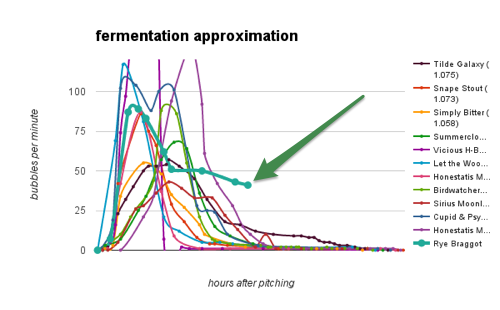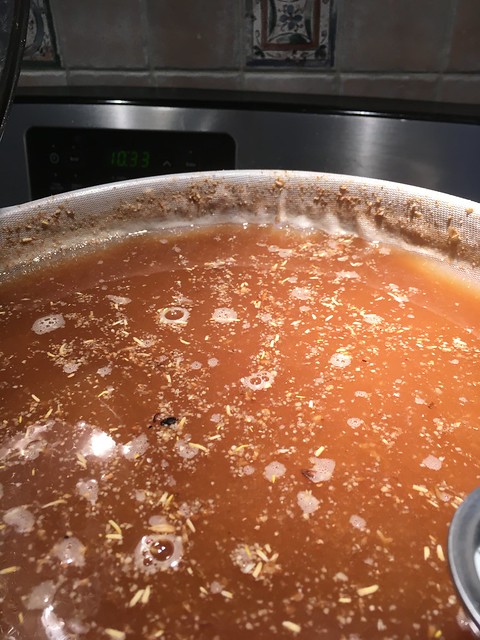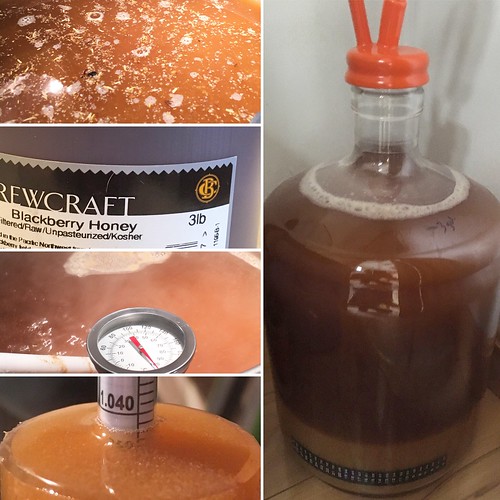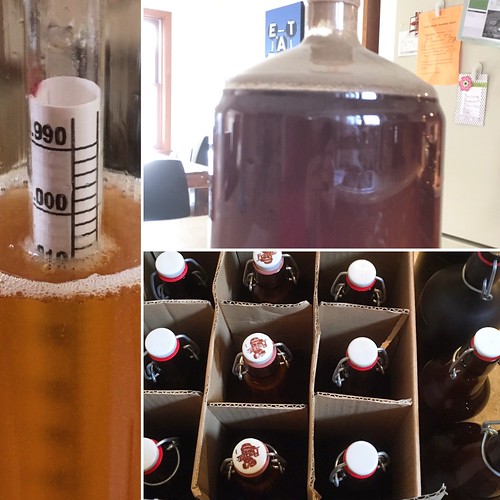Homebrew #29: Diplomatic Mission
¶ by Rob FrieselIn addition to all the homebrewing I’ve done over the past two and a half years, I’ve also been spending a lot of time around the local mead hall. As such, I’ve consumed my fair share 1 of mead. But I hadn’t yet made any. Deciding that this was an error to remedy, I combined this urge to brew 2 with my predilection for rye-based fermented beverages. A rye braggot! And (while the name came much later) thus begins the story for Diplomatic Mission:

This brew begins much as described above. In my journal, my first reference to it is in March of 2016. I was visiting the mead hall and chatting with Erik (then head brewer for Havoc) about mead, mead making, and also (for some reason) Light in the Window and rye. It’s at this point that the idea starts to take shape. Erik did not talk me out of it.
Fast-forward a couple of weeks and I find myself having much the same conversation with Ricky. This is where things start to get more specific. He’s got ideas. Recommendations. Advice on what kind of malts to throw in with the rye, and in what proportions. I mention how I just couldn’t settle on a yeast strain. He helped talk me through that decision, too. What a guy!
I plug away a bit with my formulation and I’m all set to go. And/but/so then I get caught up in brewing a bunch of other things and nine months go by. Nevertheless, December comes and I decide it’s finally time.
Brew Day
Kicking off this brew day was much like most of my other recent brews. A little milling, some strike water heating, staging of gear and ingredients… I mashed in at 149.9°F and took a pH reading with my brand new digital pH meter: 5.46 — which seemed… OK? Not that there was much I could do about modifying that pH, but it was interesting to start getting readings on this. I let the grains mash for 90 minutes before doing an iodine test (which indicated complete starch conversion). Mashed out and took a quick gravity reading: 1.032, which seemed about right. Did my boil; followed my hop schedule. I put that jar of honey into a hot water bath to soften it up while I chilled the wort. Also set my Belle Saison to rehydrating at about that time.
After the wort was cooled to 68°F, I took another gravity reading. After all the calibration adjustments, I was getting 1.040 — slightly higher than expected, but OK. And then things get… interesting.
First, the wort from the kettle exceeded the volume of the carboy. I had to deal with a bit of an overflow there. Whoops! OK. But then as I turn to grab the honey, it occurs to me: it’s going to overflow even more! So I made sure the wort was good and mixed up (no stratifying!) and poured off a little to make room. Then I started to add the honey.
Which was… clumpier than I anticipated. Perhaps I hadn’t warmed it enough? Or perhaps I had but in the confusion about my volumes it then had a chance to cool down? Regardless, I had my (sanitized!) latex gloves on and so I just did the dirty work of scooping it all out of that jar and getting it through the neck and into the carboy.
But I’m pretty sure that — looking at the clumps of honey sinking to the bottom of the carboy — not all of the fermentable sugars are in solution. BeerSmith says 3 lb. of honey will add about 35 gravity points to a 3 gallon batch. My last gravity reading was 1.040. I do another and it says 1.045. So nope: no way the honey is fully in solution. But OK… Let’s take another gravity reading, this time from the wort I “recovered” from the carboy to prevent a second overflow. Again: 1.040. With my wort readings in agreement, the rest should be simple math, right?
1.040 + 0.035 = 1.075
And feeling confident enough in those calculations, I pitched my rehydrated sachet of Belle Saison.
A Brief Aside About the Name
Since I came up with the idea for this formulation, all this time I’d just been calling it “my rye braggot”. And there’s nothing wrong with this name. It’s descriptive, if nothing else. But I like my brews to have… somewhat more spirited names. Eccentric. Whimsical. Erudite. Poetic. Evocative.
And in 2016 — that woeful year — I’d already named two of my brews after celebrities that had passed. First there was the Snape Stout that I’d named for Alan Rickman. Then there’s Sirius Moonlight, the “Vienna mit Roggen” that I named for David Bowie. So why not a trifecta?
When I heard that Carrie Fisher had died, there was a spark in my mind. Could this brew be named for her? Why wouldn’t it? The only question was, what name was appropriate? And before long, it was only too clear.

I don’t know what you’re talking about. I am a member of the Imperial Senate on a diplomatic mission to Alderaan…
Mead meets beer? There’s your diplomatic mission. And given what we know from Rogue One… Well, it seemed absolutely perfect.
Fermentation
Fermentation on this brew was fun to monitor. Less than 20 hours after pitching, there were bubbles galore in the blow-off bucket 3 and even some krausen getting pushed through. In fact… it was pushing so much krausen through the tube that I had to swap the bucket in the blow-off setup. 4 Then around +94 hours post-pitch, I notice something interesting on my graphs: the bubble activity in the bucket (as it stands in for an airlock here) is far exceeding that of any previous brew.

And it went like this for days. And then about 8 days post-pitch, I hit it with some yeast energizer and let it warm up.
At 12 days post-pitch, I took the first of several gravity readings: 1.007 — which was significantly higher than the 0.996 that BeerSmith estimated. Fifteen days post-pitch: 1.005. Eighteen days post-pitch: still 1.005. But this seems… acceptable to me. Especially after reviewing the BJCP braggot style guidelines and a few real world stories. 1.005 it is.
Packaging
While I didn’t have the same blackberry blossom honey, I had some decent-tasting wildflower honey that I could use for priming. So that’s what I did — portioned out an appropriate quantity for that, mixed it with a pint of water and boiled it for 15 minutes. After the priming solution cooled, I racked the braggot onto the mixture and proceeded to bottle. I decided to use my flip-tops, thinking I’d use most (but not all!) of them. And then I did (in fact) use up all of them.
- 10 × 500 ml bottles
- 1 × 1000 ml bottle
- 2 × 750 ml bottles
- 3 × 24 oz. bottles
So… just over 2.5 gallons. Not a bad haul.
And then… we wait.
Impressions
Overall impressions? Not exactly what I was going for, but still quite tasty, and some valuable lessons learned. First of all, it has a nice bouquet — a faint honey sweetness that lingers around the edges of floral and blackberry notes. (I had no idea the blackberry would actually be discernible considering that there’s no actual fruit in it.) On the palate, the braggot takes on a vinous character; mouthfeel is somehow simultaneously viscous and dry. The flavor leans mostly to the honey; the spicy qualities of the rye are subtle and show up to add a complexity to the otherwise honey-dominated profile. As for those coveted peppery esters from the saison yeast? It isn’t that they’re absent, but they don’t come through as strongly as I’d hoped. Perhaps if I’d fermented at a warmer temperature? Another noteworthy item here: for a beverage that, according to my measurements at least, comes in at 9.3% ABV… it sure doesn’t drink like it. It’s very smooth, and no alcohol burn at all.
Would I brew this again? After having sampled only a couple of them, it’s hard to say for sure. I think after I’ve allowed a couple of these bottles to age, I might have a better sense of that. What is this going to taste like at 3 months? At 6? Twelve? I’m skeptical of the ideas out there that mead takes “months” to fully ferment; though I do believe that some beers and other beverages benefit from a lengthy maturation time.
If asked today what I’d do different with this brew, I suspect I’d do the following:
- Even more rye. Possibly all rye. As is, I used rye for 63% of the grist, with some 2-row to boost the overall diastatic power. But rye can fully convert so… why not just use all rye? And if I can get my hands on crystal rye, use that for color and sweetness.
- More hops? Just a little more bitterness (particularly on the finish) would provide a bit better balance. Supposedly this is 35 IBU but it doesn’t finish like one.
- Ferment at a warmer temperature to encourage the yeast to show their character a little more. And/or maybe switch from Belle Saison to something like 3711, 3724, WLP566, or WLP565.
- Cold crash and/or fine. I can’t believe I forgot to do that.
Considering I have no solid baseline for braggots, I think I did pretty well here. It’s certainly enjoyable. Now to decide if it’s worth sacrificing a few flip-top bottles to enter this one into competition…
Recipe
The all-grain (BIAB) recipe for Diplomatic Mission is as follows.
Mash Grains
- 2 lb. 10 oz. Briess rye malt
- 1 lb. Briess 2-row brewer’s malt
- 8 oz. Briess 120L caramel malt
Fermentables
3 lb. raw/unpasteurized blackberry blossom honey
Hop Schedule
- ¼ oz. Columbus (35 min.)
- ¼ oz. Columbus (10 min.)
Yeast
Danstar Belle Saison
Brew Day
- Collect 16.75 qt. water and heat to 152.7°F. Mash in; hold at 147.9°F for 90 minutes. Mash out by heating to 168°F and holding for 10 minutes.
- Remove filter bag from water. Squeeze filter bag to extract as much liquid as possible for wort.
- Bring to a boil. Boil for 60 minutes; follow hop schedule described above.
- Approx. 30 minutes before the end of the boil, submerge the container of honey in very hot water in order to soften it.
- Cool to 70°F (or below) as rapidly as possible; top-off as necessary to reach 3 gallons.
- Remove honey from hot water bath and add to cooled wort.
- Aerate wort; rehydrate and pitch Belle Saison yeast.
- Place in fermentation chamber and ferment at 68°F. Don’t be alarmed if the temperature gets into the low-to-mid-70s.
Beyond Brew Day
- Allow fermentation to complete (approx. 2 weeks) at approx. 68°F.
- After reaching terminal gravity, consider cold crashing for 1-2 days before packaging.
- Use honey to prime on bottling day. Rack braggot into bottling bucket and bottle.
- Allow at least 2 weeks to carbonate. 4 is better.
- Enjoy.
Details
Diplomatic Mission, a rye braggot by Tilde Gravitywerks
| Original Gravity | 1.075 |
| Final Gravity | 1.005 |
| ABV | 9.3% |
| Attenuation | 92.9% |
| IBU | 35 |
| SRM | 13 |
| Links | Untappd Flickr |
- Maybe more than my fair share.[↩]
- Some would argue that brew is not the correct verb for mead production. Pretty sure this is discussed in an episode of Ask the Meadmaker. But I can’t remember which one. And I can’t remember what verb was settled on. But recently they used “brew” — and brew is simple, so I’ll use brew here.[↩]
- Yes, I remembered to just start with a blow-off bucket this time around. There’s almost no headspace in a 3 gallon carboy for a 3 gallon batch, after all.[↩]
- On that note: (1) sorry I don’t have a picture of that! and (2) it’s worth noting here that I was laid up in bed that day with a very gnarly stomach bug and it was miraculous that I got my shit together to attend to this. Things could have gotten very gross.[↩]
About Rob Friesel
Software engineer by day. Science fiction writer by night. Weekend homebrewer, beer educator at Black Flannel, and Certified Cicerone. Author of The PhantomJS Cookbook and a short story in Please Do Not Remove. View all posts by Rob Friesel →5 Responses to Homebrew #29: Diplomatic Mission
Pingback: 2017 GNMHC Results | found drama
Pingback: Homebrew #40: Imposter Syndrome (The Mead Day Mead) | found drama



Leave a Reply